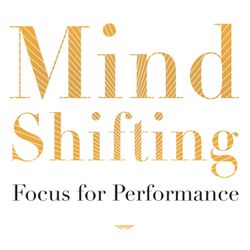Latest episode

Ch 25: Who Are You
18:45|Consciousness is made of attention and intention. Attention helps you see more clearly, like when you shine a flashlight in a dark room. That flashlight is also healing. Wherever you focus with acceptance, you heal, including in yourself and others. Intention transforms the energy of attention into information. Inquiring into your own attention and intention enables you to get to know who you are. You are not your thoughts. You are not what you do for work. Our personalities are a fiction. We get attached to this story, but we can get behind our egos to understand our real needs and wants. Our life becomes more joyful and fulfilling when we remember who we really are. In addition, this clarity helps us become more flexible, effective and impactful as leaders. Meditation is self-focused attention with empathy. Experiment: Self-inquiry meditation Experiment: Experiencing subtle forms of communication
More episodes
View all episodes

Ch 24: Mindful Coaching
19:45|Coaching is a powerful skill for leaders and professionals. Mindful coaching is about helping others reflect in the context of a safe relationship. Silence and Caring are at the heart of mindful coaching. When coaches provide accepting attention it is healing in itself. There are two phases of mindful coaching: Assessment and Goal-setting. Assessment is about seeking understanding and has two key components: Active listening Focused InquiryGoal-setting is about planning and action and has two key components: Brainstorming Committing to actionThere are three levels and modes of operating as a mindful coach:Sounding BoardSkills Development TrainerTransformational AgentGenerally we avoid giving advice because our goal is for clients to learn to think for themselves. Questions help us avoid taking over and invite reflection. However, if a client is about to make a costly mistake that could affect their career, we can temporarily step out of our neutral stance and go into expert mode to provide advice. Experiment: Receiving coachingExperiment: Providing coaching Experiment: Increasing the power of questions Experiment: Giving constructive feedback
Ch 23: Organizational Goals & Focus
17:38|In this chapter I tell the story of an organization that successfully engaged employees in a bottoms up goal-setting process. This involved two MindShifts: moving from Personal Accountability to Organizational Accountability, and moving from Task Analysis to Market Analysis.I outline a five-step process to set and implement an organization’s goals: 1. Participative goal-setting: soliciting employee involvement in establishing goals.2. Communication: articulating goals and validating understanding.3. Execution: planning and implementing effective strategies and processes.4. Accounting: setting up appropriate measures to keep track of progress toward goals.5. Reflection: periodically reviewing results and modifying processes. Experiment: Setting goals within your organization
Ch 22: Goal-setting & Development Planning
15:56|Goals are helpful in focusing attention. However, when we get too attached to goals our focus narrows and we lose track of our process. Goals are a reference point, but not helpful as an ongoing focus. Checking the score too much while playing the game is a surefire way to psych yourself out. A good development plan keeps you focused on how you are going to reach your goals and what skills you want to learn on the way. I provide a sample plan and show you how to articulate SMART goals, actions and metrics. Development plans are different from performance goals. Development plans are about the ‘how’. Performance goals are the ‘what’. Unfortunately, most organizations focus employees on performance goals that are set top down, rather than inquiring into employee aspirations and setting bottom up development goals. Don’t worry about creating the perfect plan. Just take one step and commit to one action at a time. You can evolve and elaborate your plan over time. Development plans are best thought of as living documents rather than one and done activities. Experiment: Completing your development plan
Ch 21: Prioritization & Time Management
19:04|We manage time and priorities best when we focus on managing ourselves and our attention. There is one fundamental time management question and two key follow up questions: What is the most important thing to do right now? What are the full range of my choices? What are the consequences of pursuing any one goal or activity?Experiment: Creating a self-management systemExperiment: Self-management and time management checklistExperiment: Avoiding overcommitment Experiment: Aligning tasks and purpose
Ch 20: Multitasking & Technology
14:07|We can increase our self-control and ability to focus. In addition, we can improve our ‘executive functions’. These enable us to organize ourselves and manage the demands of our lives. Multitasking is seductive but makes us error prone and makes it harder to focus in the future. It is essentially neurotoxic as it thins our prefrontal cortex. We need to intentionally set boundaries on technology, for example, how often we check our email. And we need to decide whether we need to respond instantaneously. If we are clear on our limitations we can use technology to help us focus rather than be its slave. Experiment: Mindful consumption Experiment: Email and communication breaks
Ch 19: Tolerating Uncertainty & Managing Change
18:17|We live with constant uncertainty and change in modern life. To be able to be effective we need to learn to ride the waves of our feelings and use the information we get from them. We can learn to trust our inner process as well as group processes. Change has a predictable series of stages along with emotional responses and behavioral signs. Empathy and communication help us and our teams through the process of change:DenialAnger/Depression/AnxietyDisorientation AcceptanceExperiment: Softening impatience & frustration Experiment: Distinguishing control from choiceExperiment: Helping yourself and your team through change